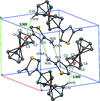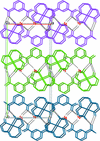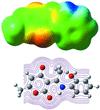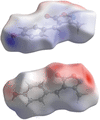issue contents
August 2022 issue

Cover illustration: Coordination compounds of triazole-containing ligands and transition-metal ions have been studied over the past years because of their possible applications in the fields of molecular magnetism, catalysis, electrochemistry, or cluster engineering, to cite just a few. This paper reports the synthesis and crystal structure of a new homobinuclear iron(II) complex, μ-oxalato-bis{bis[3-methyl-5-(pyridin-2-yl)-1H-1,2,4-triazole]iron(II)} bis(toluenesulfonate) 2.75-hydrate, [Fe2(C2O4)(C8H8N4)4](CH3C6H4SO3)2·2.75H2O, with the chelating ligand 3-methyl-5-(pyrid-2-yl)-2H-1,2,4-triazole, in which the binuclearity is obtained through a bridging oxalate anion. See: Petrenko, Bibik, Khomenko, Doroshchuk, Gural'skiy, Shova, Lampeka & Raspertova [Acta Cryst. (2022). E78, 829–832].
research communications
















































 journal menu
journal menu












































